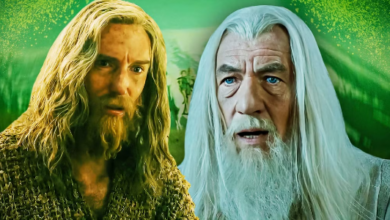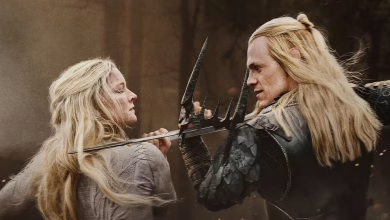Why Sauron Can Change Form on The Rings of Power
The new season of The Rings of Power opens with Sauron, though you may not know it. The first episode starts with a flashback to the beginning of the Second Age when Sauron attempts to seize power after the defeat of his master, the dark lord Morgoth, at the hands of angels called the Valar, elves, and men. But this isn’t the Sauron we met last season. It’s a Sauron played by a completely different actor—and this may be just the first of many forms that Sauron takes in the series.
In Season 1, the dark lord was played by Charlie Vickers. But in this Season 2 scene he’s played by Jack Lowden, best known for Slow Horses, Dunkirk, and—fun fact—being married to Oscar-nominated actor Saoirse Ronan.
But Sauron doesn’t keep this form for long. After Adar (played here by Sam Hazeldine, taking over from Season 1’s Joseph Mawle) and his orcs murder this version of Sauron, the dark lord turns into a pile of black goo reminiscent of the Spider-Man villain Venom. He then eats some bugs, graduates to snacking on humans, and eventually takes on the form of Halbrand (a.k.a. Vickers). Sauron changes form again in the early episodes of the season, though much less dramatically, when he dons a flat-ironed blonde wig to disguise himself as a god-like being named Annatar.
So, what gives with all these changes? Here’s everything you need to know about Sauron, his origins in J.R.R. Tolkien’s The Lord of the Rings books, and his many forms.
Why can Sauron change forms?
In Tolkien lore, Sauron is a Maia spirit (basically an angel) who becomes corrupted. One of his main powers is shape shifting.
Sauron initially serves the evil lord Morgoth. When Morgoth is defeated, Sauron tries to take Morgoth’s place. Jack Lowden plays this iteration of Sauron in The Rings of Power.
Adar was an original Rings of Power creation, which means there’s no record in Tolkein’s works of who he was or what he did. Though Sauron changes form after Morgoth’s defeat in Tolkien’s story, he was not (as far as we know) killed and reborn by a rival.
But in the show, when Sauron is murdered by Adar, he emits a beam of light and then turns into black gunk. After consuming the flesh of various beings he takes on a humanoid form, names himself Halbrand, and pretends to be the long-lost King of the Southlands.
Why does Sauron take on a new body?
In theory, Sauron could take on the form of actor Jack Lowden again. Why doesn’t he? A number of people would be wary of Sauron in this form, particularly Adar and Galadriel. By donning a new disguise, Sauron tricks his enemies.
Taking the form of Halbrand allowed Sauron to enter the Southlands and get close to Adar without being identified. In Season 1 Adar does not recognize Sauron in the form of Halbrand and is still under the impression he killed Sauron. In Season 2, when Adar captures “Halbrand,” he continues to think the man before him is the King of the Southlands, not the dark lord in disguise.
And we don’t know what form Sauron took when he was fighting alongside Morgoth. If he looked like Jack Lowden, Galadriel, or the other elves might recognize him when he came across their path: Galadrield’s brother, Finrod, died at Sauron’s hand, and Galadriel has been hunting him ever since.
Why does Annatar look so much like Halbrand?
This is a tougher question to answer. In Tolkien’s writing, Sauron appears to the elven-smith Celebrimbor in the “fairest” form that he can think of. He casts himself as Annatar, which translates in one of Tolkein’s many made-up languages to lord of gifts.
The show has already diverged from Tolkien’s work in that Celebrimbor met Sauron as Halbrand, a show creation. The elves are losing their immortality, and Halbrand helps Celebrimbor figure out how to turn the rare metal mithril into jewelry that can sustain the elves. Initially, Celebrimbor plans to make a crown using the metal.
But then Sauron reveals his true identity to Galadriel at the end of Season 1. In theory Galadriel could have immediately told Celebrimbor who Halbrand was. But she keeps Sauron’s secret because she believes the elves need the powerful mithril jewelry. Instead, she proposes that Celebrimbor forge three rings, thus distributing the mithril’s power among three elves, rather than granting all the power to one elf.
Galadriel does warn Celebrimbor not to work with Halbrand again without giving any specifics. Now Sauron needs to convince Celebrimbor to let him into his workshop for a second time, despite Galadriel’s vague instructions.
Sauron accomplishes this by returning as Halbrand but then “revealing” in Episode 2 that, in fact, he is a messenger from the gods named Annatar. He claims that he has been trying to help give Celebrimbor divine inspiration all along and is only revealing his identity now because he and Celebrimbor have become so close. This reveal is accompanied by Sauron transforming himself into an elven form very similar to Halbrand but with long blonde hair and pointy ears. I guess Sauron thinks that elves with blowouts are “fairer” than scruffy-looking humans, though Aragorn might take issue with that.
Celebrimbor falls for this line of reasoning, perhaps because he’s eager to cement his own legacy as the greatest smith in Middle-earth’s history. Plus the messenger that Gil-galad, the king of the elves, sent to warn Celebrimbor about Halbrand’s true identity was conveniently murdered en route to Celebrimbor’s forge.
Why is Sauron just a big, burning eye in The Lord of the Rings movies?
Peter Jackson’s movies took a bit of creative license on this front. In the books, when Sauron is defeated, he abandons his physical form and lives on just as a spirit. But he is able to cobble a body back together by the events of Lord of the Rings. The book The Hobbit briefly mentions that Sauron takes the form of “the Necromancer” and captures Gandalf. And Gollum sees Sauron as a shadowy figure missing a finger when he is tortured in Mordor in The Fellowship of the Ring.
But his body is weak and vulnerable until he attains the ring. So he’s more of a lurking presence in the books than an actual physical force—his henchmen largely do his dirty work for him. And while the burning eye does exist in the text, it’s not the physical manifestation of Sauron but more a tool.
Jackson’s movies needed something more imposing than a vague shadow to represent the villain. So Jackson ran with the imagery, and Sauron physically manifests almost exclusively as a burning eye atop the dark tower, Barad-dûr. It turns toward Frodo every time the hobbit puts on the one ring.
Sauron appears in a humanoid form two times in The Lord of the Rings movies, once in a flashback to the battle between Sauron and the Alliance of Elves and Men at the end of the Second Age (a battle that will likely cap off the Rings of Power TV show) and once when Aragorn gazes into a magical device called a palantir and sees Sauron in his black armor. Jackson did bring a vaguely humanoid version of Sauron to screen in the Hobbit movies as the Necromancer.



